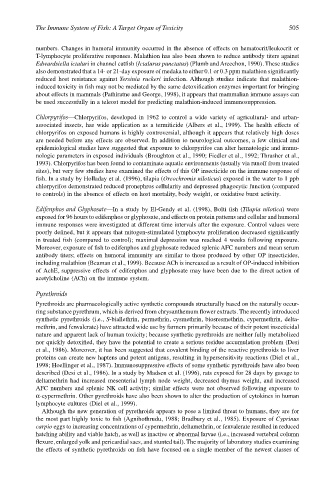Page 525 - The Toxicology of Fishes
P. 525
The Immune System of Fish: A Target Organ of Toxicity 505
numbers. Changes in humoral immunity occurred in the absence of effects on hematocrit/leukocrit or
T-lymphocyte proliferative responses. Malathion has also been shown to reduce antibody titers against
Edwardsiella ictaluri in channel catfish (Ictalurus punctatus) (Plumb and Areechon, 1990). These studies
also demonstrated that a 14- or 21-day exposure of medaka to either 0.1 or 0.3 ppm malathion significantly
reduced host resistance against Yersinia ruckeri infection. Although studies indicate that malathion-
induced toxicity in fish may not be mediated by the same detoxification enzymes important for bringing
about effects in mammals (Pathiratne and George, 1998), it appears that mammalian immune assays can
be used successfully in a teleost model for predicting malathion-induced immunosuppression.
Chlorpyrifos—Chlorpyrifos, developed in 1962 to control a wide variety of agricultural- and urban-
associated insects, has wide application as a termiticide (Albers et al., 1999). The health effects of
chlorpyrifos on exposed humans is highly controversial, although it appears that relatively high doses
are needed before any effects are observed. In addition to neurological outcomes, a few clinical and
epidemiological studies have suggested that exposure to chlorpyrifos can alter hematologic and immu-
nologic parameters in exposed individuals (Broughton et al., 1990; Fiedler et al., 1992; Thrasher et al.,
1993). Chlorpyrifos has been found to contaminate aquatic environments (usually via runoff from treated
sites), but very few studies have examined the effects of this OP insecticide on the immune response of
fish. In a study by Holladay et al. (1996), tilapia (Oreochromis niloticus) exposed in the water to 1 ppb
chlorpyrifos demonstrated reduced pronephros cellularity and depressed phagocytic function (compared
to controls) in the absence of effects on host mortality, body weight, or oxidative burst activity.
Edifenphos and Glyphosate—In a study by El-Gendy et al. (1998), Bolti fish (Tilapia nilotica) were
exposed for 96 hours to edifenphos or glyphosate, and effects on protein patterns and cellular and humoral
immune responses were investigated at different time intervals after the exposure. Control values were
poorly defined, but it appears that mitogen-stimulated lymphocyte proliferation decreased significantly
in treated fish (compared to control); maximal depression was reached 4 weeks following exposure.
Moreover, exposure of fish to edifenphos and glyphosate reduced splenic AFC numbers and mean serum
antibody titers; effects on humoral immunity are similar to those produced by other OP insecticides,
including malathion (Beaman et al., 1999). Because ACh is increased as a result of OP-induced inhibition
of AchE, suppressive effects of edifenphos and glyphosate may have been due to the direct action of
acetylcholine (ACh) on the immune system.
Pyrethroids
Pyrethroids are pharmacologically active synthetic compounds structurally based on the naturally occur-
ring substance pyrethrum, which is derived from chrysanthemum flower extracts. The recently introduced
synthetic pyrethroids (i.e., S-biallethrin, permethrin, cysmethrin, biosresmethrin, cypermethrin, delta-
methrin, and fenvalerate) have attracted wide use by farmers primarily because of their potent insecticidal
nature and apparent lack of human toxicity; because synthetic pyrethroids are neither fully metabolized
nor quickly detoxified, they have the potential to create a serious residue accumulation problem (Desi
et al., 1986). Moreover, it has been suggested that covalent binding of the reactive pyrethroids to liver
proteins can create new haptens and potent antigens, resulting in hypersensitivity reactions (Diel et al.,
1998; Hoellinger et al., 1987). Immunosuppressive effects of some synthetic pyrethroids have also been
described (Desi et al., 1986). In a study by Madsen et al. (1996), rats exposed for 28 days by gavage to
deltamethrin had increased mesenterial lymph node weight, decreased thymus weight, and increased
AFC numbers and splenic NK cell activity; similar effects were not observed following exposure to
α-cypermethrin. Other pyrethroids have also been shown to alter the production of cytokines in human
lymphocyte cultures (Diel et al., 1999).
Although the new generation of pyrethroids appears to pose a limited threat to humans, they are for
the most part highly toxic to fish (Agnihothrudu, 1988; Bradbury et al., 1985). Exposure of Cyprinus
carpio eggs to increasing concentrations of cypermethrin, deltamethrin, or fenvalerate resulted in reduced
hatching ability and viable hatch, as well as inactive or abnormal larvae (i.e., increased vertebral column
flexure, enlarged yolk and pericardial sacs, and stunted tail). The majority of laboratory studies examining
the effects of synthetic pyrethroids on fish have focused on a single member of the newest classes of

